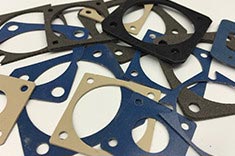EMI Shielding Products
- Custom Gasket Fabrication
- Connector Gaskets
- Bonded O Ring
- Custom Gaskets
- Conduct-O-Knit Knitted Wire Mesh
- Conduct-O-Seal Combo Gasket
- Conduct-O-Elastomer
- Conduct-O-Seal Oriented Wire in Silicone Gasket Material
- Conduct-O-Mesh Tape
- Conduct-O-Foam
- Conduct-O-Bond
- Optical Filters For Electronic Displays
- Shielded Vent Panels
- ESC Board Level Shielding
- 300 Series
How do EMI Shields Work?
Have you ever wondered how EMI and RFI shielding work? These types of shields surround objects (metal plates or other materials) to block electromagnetic fields. EMI shield is carefully designed to diminish radiated emissions from getting past specific points of electrical equipment. In many cases, EMI shielding is necessary to protect devices from external radiation, as well as preventing the device from emitting radiation that affects devices near it.

What exactly happens when electromagnetic interference waves hit an EMI shield? Below, we want to take some time to go over the basic principles of how EMI shielding works.
EMI Shielding
Conductive surfaces of a shield can reflect most energy from an EM wave that hits it in various directions. How waves reflect depends upon the characteristics of the shield design. Also, the phase of the wave, when hitting the shield, directs the way waves reflect. The EM I that is not reflected gets absorbed by the shield and converted into heat energy. In certain conditions, like when power levels are involved, heat energy produced can necessitate thermal management.
Some shielding material functions as a heat sink and a shield. You will commonly find this in high-powered electrical circuits. You potentially need openings in the shield material to release heat, especially when using a shielding mechanism known to absorb more energy.
It is important to note that shielding needs a secure ground connection to function correctly.
EMI RFI Shielding
For more information on EMI RFI shielding and shielding gaskets, you should not hesitate to give our team a call.
Related Reading:
- The Importance of EMI Shielding for Modern ElectronicsWithout a doubt, EMI shielding is an essential tool that is used every day. Most people do not realize that modern electronics could not work at optimal levels without the benefits found from EMI and RFI gaskets.
- Important RF Shielding Terminology
- Tips for Choosing Shielding Materials



